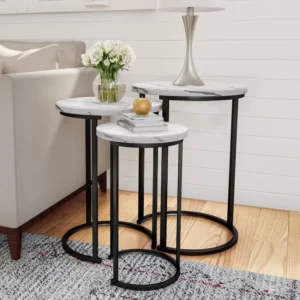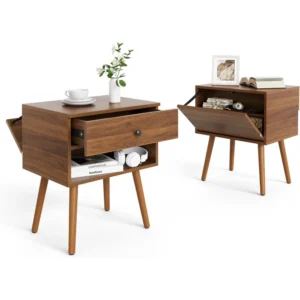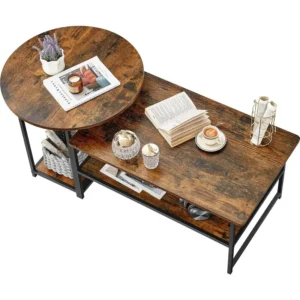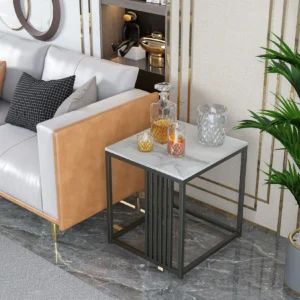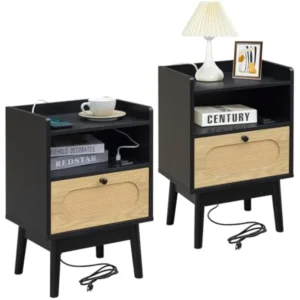Mid-Century Modern Nesting Side & End Tables
Get iconic mid-century style and save space. Nesting side and end tables offer flexible surfaces for drinks or decor, tucking away neatly when not in use. Simple, stylish, practical.
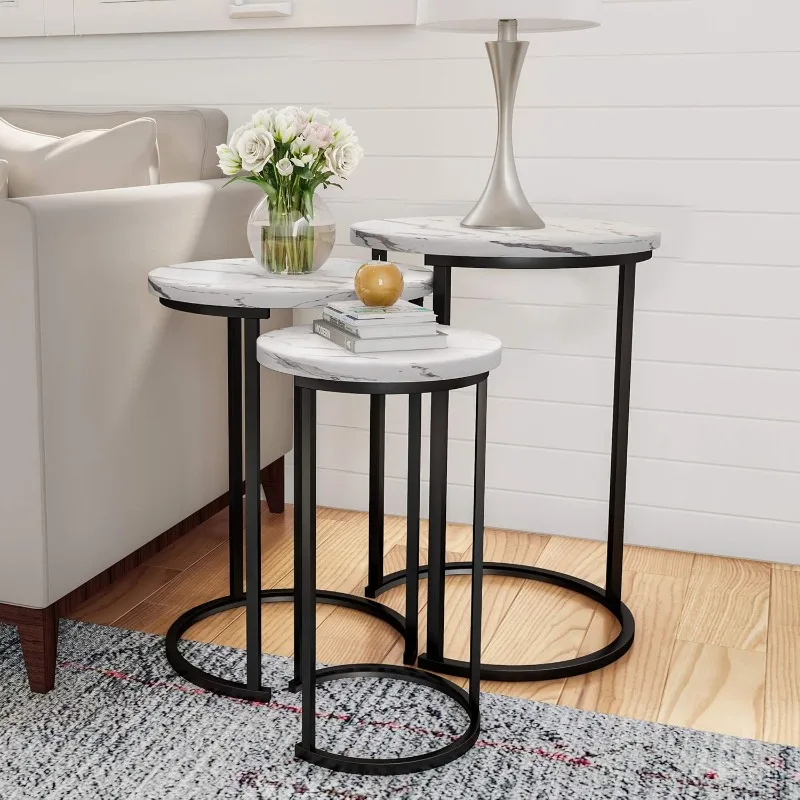
Showing all 2 results
Mid-Century Modern Nesting Side & End Tables, Mid-Century Modern Nesting Table Sets, Mid-Century Modern Round Side & End Tables
Price range: $239.35 through $273.06 Select options This product has multiple variants. The options may be chosen on the product pageMid-Century Modern End Table Sets of 2, Mid-Century Modern Nesting Side & End Tables, Mid-Century Modern Small Side & End Tables
Price range: $327.67 through $547.47 Select options This product has multiple variants. The options may be chosen on the product page
Showing all 2 results
What Are Mid-Century Modern Nesting Side & End Tables?
Mid-century modern nesting tables are ingenious space-saving furniture sets where smaller tables tuck neatly beneath larger ones, creating a compact, unified footprint when not in use. These versatile pieces function beautifully as both side and end tables, offering multiple surface options that can be deployed or consolidated as needed. Born during the influential design movement of the 1950s-1960s, these tables exemplify the era’s commitment to functionality paired with elegant simplicity.
Distinguished by clean lines, tapered legs, and organic shapes, nesting tables remain as relevant today as they were during their heyday. Drawing inspiration from masters like Eames and iconic Scandinavian design, these tables typically feature warm woods like walnut and teak, often complemented by glass surfaces or subtle metal accents. At Hearth Forms, we celebrate these pieces as perfect embodiments of mid-century design’s enduring legacy.
Space-Saving Design: The Versatile Home Solution
The ingenious nesting concept makes these tables ideal for modern living where space optimization is essential. When entertaining guests, the tables can be separated and distributed throughout a room, providing convenient surfaces for drinks and snacks. When not needed, they nest together, occupying the footprint of just one table—perfect for apartments, cozy living rooms, or multifunctional spaces.
This transformative quality offers remarkable versatility; a three-piece nesting set can provide the functionality of multiple end tables while storing in roughly 2 square feet when nested. For small-space dwellers, this space efficiency is invaluable, allowing for entertaining capabilities without sacrificing precious floor area. These tables adapt to your needs rather than forcing your lifestyle to adapt to your furniture—a core principle of thoughtful mid-century design.
Signature Mid-Century Design Elements
Mid-century modern nesting tables capture the essence of the era through several distinctive design characteristics. Their clean, minimalist lines create visual harmony, while organic shapes add a touch of playful sophistication. The legs—typically tapered or gracefully splayed—provide both stability and elegant visual movement, appearing to dance lightly beneath the table surfaces.
Natural materials take center stage, with wood varieties selected for their rich grain patterns and warm tones. The careful balance of functional simplicity and refined elegance defines these pieces, making them instantly recognizable to design enthusiasts. Table surfaces range from perfectly circular and oval forms to more distinctive shapes like the guitar-pick contour or rounded rectangles.
This distinctive design vocabulary sets mid-century nesting tables apart from other furniture styles. The thoughtful combinations of materials—rich woods paired with clear or smoked glass, or wood complemented by subtle metal accents—create pieces that feel both nostalgic and remarkably current, speaking to the timelessness of authentic mid-century design principles that we at Hearth Forms deeply value.
Common Materials and Construction
Quality Woods
The heart of mid-century nesting table design often lies in exceptional wood selection. Premium hardwoods like walnut, with its deep chocolate tones and expressive grain, feature prominently. Teak and oak offer alternatives with their own distinctive characters—teak bringing golden warmth, oak providing a lighter, more casual presence. At Hearth Forms, we appreciate both authentic solid wood construction for its durability and expertly applied veneers that showcase particularly beautiful grain patterns while maintaining structural integrity.
Glass Elements
Glass surfaces bring airy lightness to nesting tables, creating visual space in compact settings. Clear glass maximizes light transmission, while smoked or tinted variations add sophistication and visual depth. Beyond aesthetics, glass offers practical benefits: it’s exceptionally easy to clean and doesn’t obstruct sightlines in small spaces. Quality nesting tables feature tempered glass for safety and durability, ensuring these beautiful surfaces stand up to daily use.
Metal Accents
Metal details provide both structural integrity and design flair in mid-century nesting tables. Warm brass tones complement wood grain beautifully, while chrome brings crisp, reflective contrast. Black metal offers contemporary edge while honoring mid-century principles. These metals typically appear in legs, frames, or subtle decorative elements that enhance without overwhelming the overall design.
Versatile Functions in Modern Living
Living Room Applications
In living spaces, nesting tables truly shine as adaptable surfaces that transform to meet changing needs. During gatherings, they separate to offer individual drink tables or display platforms distributed precisely where needed. When solo relaxing, the smallest table might hold a book and tea beside a favorite chair, while the larger tables nest compactly nearby. Their lightweight construction allows for effortless rearrangement as activities shift throughout the day.
Bedroom Possibilities
As bedside tables, nesting sets offer smart solutions for different needs: a larger surface for a lamp and alarm clock, with smaller tables available for books, water glasses, or decorative elements. Their compact footprint works beautifully in bedrooms where space is at a premium, and their mobility enables easy cleaning underneath and behind the bed.
Multi-Purpose Spaces
In today’s flexible home environments, nesting tables excel by providing temporary work surfaces, plant stands, or display areas that can be reconfigured as spaces transition between functions. Their mobility makes them perfect companions in home offices that double as guest rooms or studios that serve multiple creative purposes.
Styling and Decor Pairing
Mid-century nesting tables adapt beautifully to diverse interior styles. In pure mid-century settings, they complement low-profile sofas and iconic lounge chairs perfectly. In contemporary spaces, they introduce historical design character without overwhelming modern elements. Even in eclectic interiors, their clean lines and organic shapes provide grounding elements that harmonize with diverse style influences.
For optimal styling, pair these tables with lighting that echoes their design ethos—perhaps a slender floor lamp with a linen shade positioned near the largest table. Decorative objects like sculptural ceramics, art books, or small plants enhance their appeal while maintaining functional surface area. Color palettes featuring earthy neutrals, muted teals, ochres, and burnt oranges complement the warm wood tones beautifully while honoring mid-century color traditions.
Complementary Mid-Century Modern Furniture Pieces
To create a cohesive yet collected look, consider pairing your nesting tables with other thoughtfully selected mid-century pieces. An iconic lounge chair with ottoman provides perfect counterpoint to the tables’ more diminutive scale. Coffee tables featuring similar wood tones and design motifs create visual consistency without appearing matched.
Lighting choices significantly impact the mid-century atmosphere—consider arc floor lamps or table lamps with ceramic bases and tapered shades. Storage cabinets or shelving with similar leg designs or wood finishes extend the design language throughout your space. The key lies in selecting pieces that share design vocabulary—clean lines, tapered elements, warm materials—rather than purchasing matching sets, creating a space that feels curated rather than formulaic.

